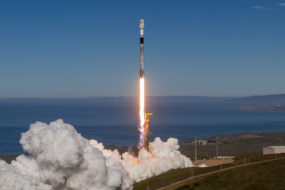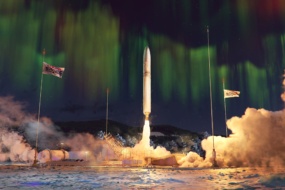The state of US launch is overwhelmingly the state of SpaceX.
SpaceX accounted for a whopping 95% of the 145 US launches last year. The launch giant provides America’s only certified domestic crewed ride to the ISS. And that’s all without talking about Starship, the company’s mega launcher that holds NASA’s future Moon and Mars ambitions in its fins.
Despite SpaceX’s dominance of the global launch industry, it’s far from the only player. Rocket Lab is hot on SpaceX’s heels, launching regular missions for military, civil, and commercial customers in the US and New Zealand.
“There’s nobody else that’s demonstrating launch cadence and reliability other than SpaceX and us,” Rocket Lab founder and CEO Peter Beck told Payload. “And, not to say that there’s not other good providers, but they’re just not demonstrating launch cadence right now.”
Many launch providers—in the US but also around the world—are working to overcome the technical (and high price tag) barriers to launch. They must do so to serve the growing space industry, which is looking for more rides to more orbits.
“There’s a variety of needs in terms of the types of payloads and where they need to be launched to,” ULA’s Mark Peller, senior vice-president for the Vulcan program, told Payload. “It will require a diversity in the marketplace in terms of launch vehicle providers and the systems that they bring.”
The race ahead won’t just be about going to space. Rather, it will be about which company can do it most often, without failures, while bringing in paychecks—and who will get left behind trying.
Breaking the barrier: Launch is widely seen as the sexy part of the space industry. It’s also technologically difficult and capital intensive, with sky-high barriers to entry. After years of investment, winners (and losers) are emerging. As a result, you don’t see many new small launch companies founded nowadays.
“Physics doesn’t care how much capital you’ve got. Poor engineering decisions don’t care how much capital you’ve got,” said Beck. “For a rocket company to come together to produce a product…and business that works is really, really hard.”
Even if a new entrant can get together the money and talent required to cross the Kármán line, success also means bringing something different to the crowded market. ULA’s key consideration was customer flexibility—and differentiating itself from the crowd.
“When we first set out to develop Vulcan, we were looking at the variety of missions required to support national security…” Peller told Payload. “That’s what we designed the system around. And, it turns out that can be a really good fit for other applications, as well for both civil and commercial.”
Relativity Space’s Chief Revenue Officer Josh Brost said he looks for three things when it comes to whether a launch company will make it:
- Can reliably launch its mission.
- Has compelling economics.
- Delivers enough launch capacity for its business.
“Everyone should reserve the right to be disrupted,” added Beck. “It’s just harder than it was before.”
Growing pains: While the launch industry has lots of demand, companies also face challenges.
A top concern for nearly every exec we spoke to? Supply chain fragility, with Beck citing it as the industry’s Achilles’ heel.
“There can be very large projects for a number of years, and then just nothing for a number of years, so it creates a lot of fragility and lack of scale within this supply base,” said Beck.
Launch site capacity is another area where supply is not meeting demand. Most US launches lift off from Florida’s space coast, creating congestion and scheduling conflicts. And, to worsen matters, more frequent launches stress local infrastructure.
Officials floated a few solutions, including:
- More infrastructure investment from industry and government
- Better communication between government agencies and launch providers
- Increased collaboration among launch providers to take advantage of every opportunity to launch.
Finally, companies have struggled with complex regulations — particularly delays in applying for the more streamlined Part 450 licensing process. While some firms have navigated the new process successfully, others are fighting for greater efficiency and predictability.
“Any time there’s a big regulatory change, both sides—regulators and operators—need to learn how to operate efficiently in that space,” said Brost.
Size matters: There’s no one-size-fits-all approach for launch. Rideshare missions offer cheaper rides to a set destination. Dedicated small launchers are more like Ubers, getting you exactly where you need to go. Heavy launch can lift lots of mass to orbit, one day enabling the building of infrastructure in space.
On the smaller side of the launch spectrum, rideshare missions such as SpaceX’s Transporter series don’t make small-dedicated launches irrelevant—in fact, they do just the opposite. Small-lift vehicles like Rocket Lab’s Electron and Firefly’s Alpha play a crucial role in meeting specific demands that larger rockets can’t efficiently support.
“We see Firefly as complementary to SpaceX,” Firefly’s Alpha Chief Engineer Jordi Paredes Garcia told Payload. “Like other transportation modes…, a small/medium/large model is critical to support the diverse needs of the launch market. Not everybody wants to ride the bus.”
However, customers looking for heavy launch also want a robust, competitive market place in the 20-ton range. That’s why Relativity abandoned Terran-1 after its first launch and pivoted to build the larger Terran-R two years ago, according to Brost.
“I think there are use cases where it can make sense to use smaller launch vehicles, but those are the more niche applications that don’t scale them the same kind of way,” said Brost. “What you’ll see is…customers who want to do their demo satellites on a small launcher and then deploy their constellation on a large launcher, as an example.”
In the end, launching is all about one thing: economics. If a vehicle is too small, it could take dozens of launches to generate the same revenue and margin as a single heavy-lift launch. If a vehicle is too big, it may not have enough demand to completely fill rides. For ULA, the economics just didn’t add up for small-lift vehicles, so the firm stuck with the heavy-lift market.
“The figure of merit we always look at is dollars per pound to orbit, or dollars per spacecraft. Those economics just get better as you go up to medium- and heavy-lift,” Peller told Payload.
Reusability: Many startups are incorporating first-stage reusability as a tool to cut manufacturing costs (and time) and boost launch cadence—and with it, their profits.
Second-stage reusability, however, remains a more nuanced conversation. According to Beck, it makes sense at a large scale like Starship, but not so much for the mediumlift category like Rocket Lab’s Neutron or SpaceX’s Falcon 9.
“You notice that Elon never ever did a reusable second stage for a Falcon 9,” said Beck. “That’s because the economics make no sense to do that, but it does make sense on a very large launch vehicle.”
For missions beyond LEO, reusability can take on a different form. Peller explained how flying back doesn’t make sense technically and economically for Vulcan. That is why ULA is developing “Smart Reuse”— a future Vulcan upgrade focused on non-propulsive, downrange recovery of just the first-stage engines.
“We’re not using any fuel to support reuse, so all that fuel can be used to support the primary mission and deliver the most value to our customer downrange,” said Peller. “We’re recovering…just the engine module…the majority of the value of the booster.”
The final word: Despite all of these challenges in navigating the industry, the officials we spoke to were optimistic about the opportunities for “a new era” of launch, in Brost’s words.
“Things are changing in many ways…it’s a very dynamic business to be operating in right now, and a really exciting time,” said Peller.




